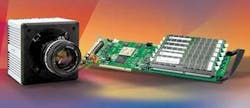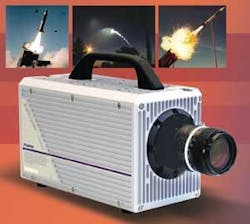By Andrew Bridges
When Eastman-Kodak announced it was ceasing production of its chrome-based VNF color-reversal film at the Optical Systems Group meeting last year it was clear to many that the transition to digital imaging would happen sooner rather than later.
The move from older, proven equipment to “newfangled” digital technology is never an easy one, and rarely is it willingly embraced. While some organizations have chosen to stockpile large quantities of film, many others have investigated the availability of commercial off-the-shelf (COTS) alternatives to see how readily these imaging systems can replace their aging 16-, 35-, and 70-millimeter film camera inventory. Military test ranges have led the transition, swiftly seeking digital alternatives to older high-speed film technology.
Digital video
When considering the replacement of film cameras with the latest generation of video cameras, the most obvious imaging challenge to meet or overcome is spatial resolution. Standard 35-millimeter film can be digitized to a resolution of approximately 4,000 by 3,000 pixels with a TrackEye Motion Analysis (TEMA) scanner, totaling a massive 12 million pixels, or 12 megapixels, per frame.
The largest resolution achievable with a high-speed video camera at a comparable 3,000 frames per second (fps) is 1,048,576, or a little larger than one megapixel. The good news is that advances in motion-tracking algorithms have improved to where subpixel tracking accuracy is now commonplace.
Software suppliers such as Xcitex in Cambridge, Mass.-manufacturers of the popular ProAnalyst motion-analysis software-are achieving accuracies as high as one-tenth of a pixel. When these accuracies transpose over to video resolutions, a basic 1-megapixel camera becomes equivalent to more than 100 megapixels.
The high dynamic range of film is another issue that digital video systems are challenged to address and achieve. In the simplest of terms, this means that film users are afforded greater latitude when it comes to getting the exposure required spot-on; a slight change in ambient lighting, such as the sun appearing from behind clouds, has little effect on the finished product. The images are still usable, there is still detail visible in the shadows, and the highlights are not washed out.
High-speed-video manufacturers strive to overcome this dynamic-range issue by adding more bits to the pixel depth. While early systems were only eight bits (equivalent to 256 steps from white to black), current technology allows manufacturers to provide 10-bit (1,024 steps, white to black) or even 12-bit (4,096 steps) systems.
This digital advantage has its limitations, however. Anything greater than 8-bit imagery requires specialized computer hardware and displays. Some argue, moreover, as to how many bits, or steps from white to black, in reality exist in any image.
To make the most of the benefits of greater than 8-bit systems, many cameras offer the ability to optimize the displayed image by enabling users to select which 8 bits are displayed, and the highlights or lowlights from what was recorded and subsequently saved.
Electronic shutters also provide digital video users with the ability to adjust the shutter for optimum image conditions. When imaging a high-speed event, such as tracking a missile up into the atmosphere (see Fig. 1), the ability to increase or decrease the shutter timing means perfectly exposed images throughout the sequence.
FIGURE 1. High-speed photos capture an Atlas rocket launch.
The digital system allows the user to predefine a maximum shutter time, ensuring that the object to be recorded is always blur-free by avoiding overly long exposure times caused by reduced light levels such as the sun disappearing behind a cloud. The maxim in-motion analysis circles is “better underexposed than blurred.”
High-speed digital video has many other advantages over film and film processing. The results from a digital high-speed camera system are available immediately without the costs or time delay for film lab processing. A digital high-speed video system is very simple to set up; what you see on the screen when you position and focus the camera is what you will get in the saved imagery.
Video also avoids the nasty environmental concerns that have led to Eastman Kodak’s move away from products requiring heavy metals such as chrome, which is used in VNF film products. Not having to worry about the camera getting up to speed in time for the event, or running out of film before the event has occurred, are addressed by flexible triggering in which a camera remains constantly recording, replacing data in a First-In-First-Out (FIFO) fashion until a trigger signal is received.
Here is some more good news. By their very nature, high-speed video systems are available in a far wider range of configurations than film cameras ever were.
Low-cost CCD and megapixel CMOS PCI systems are designed for nearly all personal computers. Specialized systems are configured for long-record applications, such as missile launches, and intensified camera systems are designed for analyzing low-light, flame, and even combustion phenomena. Other digital video high-speed systems are for portable usage housed in lightweight, compact units.
Ruggedized, high-G systems with either one piece or with a tethered camera head for greater access to difficult or hazardous locations are designed and engineered for applications where extreme heat, cold, shock, vibration, dust, and moisture are commonplace.
Varied digital applications
The PCI systems such as the megapixel 1024 PCI (see Fig. 2) from Photron in San Diego are perfect for applications in laboratory research and production line faultfinding. It is the rugged, stand-alone, high-speed imagers, however, that are of real interest to the military test environment (see Fig. 3).
Typical military applications can be as diverse as any high-speed camera situations. These cameras must perform tasks such as recording missile launches, intercepts, and impacts; munitions firing; sabot separation; impact analysis; explosive detonations; arena tests where a detonation is first circled with screens to record where and when the screens are penetrated by fragments; bomb-hit-and-miss monitoring; onboard vehicular tests; human gait studies; parachute deployment; ballistic gelatin studies; structural integrity testing to establish a structure’s ability to withstand different impacts; and many, many more.
No single system exists that is ideally suited to every application, so high-speed-camera manufacturers continue to design systems that extend the range and capabilities of these imagers.
FIGURE 3. Photron’s APX-RS color camera is a rugged, high-speed video camera. This digital model was purchased by White Sands Missile Range to replace its aging film-style cameras.
Long-record systems provide an all-digital solution for recording events lasting as long as 15 minutes, such as intercontinental ballistic missile launches from Vandenberg Air Force Base, Calif., that include missile reentry of the atmosphere and impact into the Pacific Ocean off Kwajalein Missile Range in the Marshall Islands. For applications like this in which cameras may not be connected to one another, and in fact may be positioned several miles apart, there is the issue of how synchronize these remote systems precisely.
The answer is through the use of satellite IRIG or GPS timing. With this approach, cameras can be precisely synchronized to a commonly transmitted time base. The time corresponding to every frame is recorded on every frame for every camera, regardless of whether they are operating at the same frame rate.
When the analysts sit down to produce the complete time, space, position information (TSPI) solution, they can use this recorded time, as well as any other data recorded-such as a tracking mounts azimuth, elevation, and range data-to establish exactly where an object was and at precisely what time (see Fig. 4).
FIGURE 4. A high-speed photo sequence captures a Dragon antitank missile launch (courtesy of Redstone Arsenal).
Like their film predecessors, today’s video cameras offer dual-speed recording. At the touch of a button the user can change recording speed to a faster or slower speed thus saving available memory.
A good example of how this feature might be used involves a missile launch that requires recording speeds of at least 2,000 frames per second. Once it clears the launch pad, the recording rate can be dropped to a lower speed, like 250 frames per second, to record its flight and subsequent separation.
The latest video imagers also provide a growing list of features not available with older film camera technology. These advanced options include the ability to prevent individual pixels from being over exposed, memory partitioning (to enable multiple, short-duration events to be recorded synchronously before downloading), synchronized recording of multiple channels of external data from accelerometers, load cells, pressure cells recording blast pressures, etc.
There is the added benefit of a constantly live video feed from the camera to the control house to enable the engineers to see what happened and to determine when the site is clear after the test.
Digital missile testing
White Sands Missile Range in New Mexico is one of the first military test ranges to switch from film technology to digital high-speed imaging. Although rumored to own as many as three hundred film cameras, White Sands recently made a commitment to see how the latest high-speed video-imaging technology could meet their demanding requirements by replacing some of their aging film cameras with ultra-high-speed digital camera systems from Photron.
White Sands officials reached their procurement decision after an evaluation period, during which they and NewTec personnel bought comparable systems from three digital-video manufacturers. They performed extensive in-field live-fire tests, and verified their findings by employing an independent test house.
They decided to purchase several APX-RS cameras from Photron in the first of what is planned to be a purchase of 75 color and monochrome cameras.
At White Sands, the majority of testing has to take place very early in the morning before the FAA opens the airspace above the range to commercial air traffic. The APX-RS camera is well equipped to handle low-light conditions at dawn and dusk. In addition, White Sands often uses specialized optics such as large-format lenses with focal lengths in excess of 150 inches, or 3800 millimeters, which obviously tend to lose a lot of light. Both of these conditions factored into choosing an advanced high-speed video system that is able to compensate for these low-light settings.
With the expanding capabilities of digital technology and high-speed cameras, and new features and options becoming available, it is likely that the rapid transition from film to digital video will continue in military and commercial segments.
Advanced high-speed imagers, such as the APX-RS, fitted with 16 gigabytes of memory, can now provide 12 seconds of record time at 1,000 megapixel frames per second and four seconds of record time at the maximum full-frame speed of 3,000 frames per second (fps).
With the ability to “window down” the active area of the sensor to provide increased record speeds up to 10,000 fps with 512-by-512-pixel resolution, this technology also provides a staggering 250,000-fps top speed. With this type of performance, the digital imaging solution is an obvious choice for many diverse applications.
Andrew Bridges is with Photron Inc. in San Diego. He can be reached by e-mail at [email protected]. The author would like to acknowledge Photo-Sonics in Burbank, Calif., for their contribution to this article.




